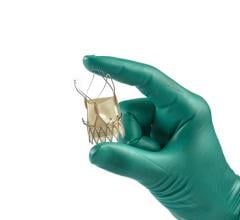July 15, 2014 — Surgical aortic valve replacement generally improves patients’ symptoms and prolongs survival. However, the perceived risk of surgical aortic valve replacement in patients over 80 may result in surgery being denied or a recommendation for alternative therapy. Investigators at the Mayo Clinic challenge the way these patients have been managed. They report that repeat sternotomy in patients over 80 who have previously had coronary bypass graft surgery can be done with low risk. Their findings are published in The Journal of Thoracic and Cardiovascular Surgery, an official publication of the American Association for Thoracic Surgery.
“Our experience is that the prevalence of operative morbidity and mortality is the same as for primary sternotomy and surgical aortic valve replacement,” says lead investigator Kevin L. Greason, M.D., Division of Cardiovascular Surgery, Mayo Clinic, Rochester, Minn. “Based on the available evidence, there is no compelling argument to abandon the technique in favor of transcatheter replacement. Repeat sternotomy for surgical aortic valve replacement is a safe option.”
The outcome of non-surgical management in elderly patients with symptomatic severe aortic valve stenosis is disappointing. A prior study demonstrated that nearly half of patients in their 80s who were treated with aggressive medical therapy died within a year. There is general agreement that such patients benefit from surgical aortic valve replacement. Earlier studies have shown that this appears to be as safe as transcatheter replacement and that there was no difference in 30-day operative mortality rates in patients who received transcatheter replacement versus surgical replacement. But little is known about the potential risks of repeat surgery.
To assess these risks, investigators reviewed the records of 629 octogenarian patients who had narrowing of the aortic valve in the heart and who had undergone sternotomy between January 1993 and December 2011. Of these, 111 patients (17.6%) had received a previous coronary artery bypass graft and therefore a repeat sternotomy was required. All patients had their surgery at the Mayo Clinic.
Those patients who underwent a repeat sternotomy had more pre-existing conditions and a higher predicted risk of death than those undergoing primary sternotomy. Despite the higher risk, the results in the repeat sternotomy group were similar to those in patients who received primary sternotomy. The cardiopulmonary bypass time was longer in the repeat sternotomy group compared with the primary sternotomy group, but there was no difference in the aortic crossclamp time between the two groups. Stroke occurred in three patients (2.7%) after repeat sternotomy and in 10 patients (1.9%) after primary sternotomy. Rates of myocardial infarction, renal failure, and reoperation for bleeding were similar between the two groups. Seven patients (6.4%) died after repeat sternotomy and 19 patients (3.7%) died after primary sternotomy. There were no deaths in the seven patients who received either a third or fourth sternotomy.
“The main finding in our study is that repeat sternotomy is not a predictor of operative mortality for isolated surgical aortic valve replacement,” says Greason. “Repeat sternotomy and surgical aortic valve replacement can be done with low risk in patients in their 80s.” He observes, however, that “These patients were operated on at a high-volume center and were selected for operation by a group of surgeons well versed in complex reoperative cardiac surgical procedures, so these results may not be reproducible at centers without the same degree of experience. An option may be to refer these patients to a specialist center.”
For more information: www.jtcvsonline.org


 October 23, 2024
October 23, 2024 








